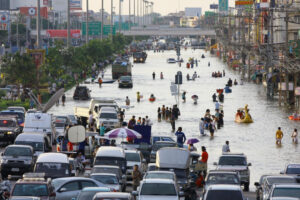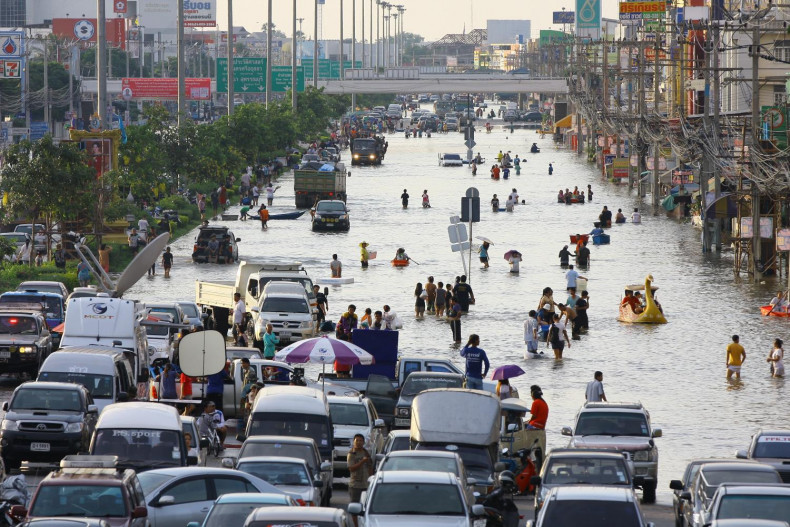
Thailand’s Floods, ‘a recurring nightmare’
Bangkok Post Opinion: George G van der Meulen & Chamniern Vorratnchaiphan
Thailand has faced floods for more than a century. Some years are worse than others, but the pattern is consistent. The catastrophic 2011 floods remain the most painful reminder: according to the World Bank, they caused US$46.5 billion (1.5 trillion baht) in economic losses, displaced 13 million people, and claimed approximately 800 lives. Much of the country’s industrial heartland was submerged for months, severely impacting global supply chains.
Fast forward to 2025, and the story is largely unchanged. Recent floods in Nan (July), Chiang Mai (August), and Phetchabun (September) highlight that devastating inundations continue to occur.
Flooding is not limited to rural provinces; Bangkok itself has endured severe inundations in 1938, 1995, and 2011.
Major floods also struck provinces in 1983, 2000, 2010, 2013, 2014, 2016, 2019, 2024, and 2025. The frequency of such events underscores how deeply entrenched this problem is in Thai life.
Why Floods Happen So often
Floods in Thailand are the product of both natural conditions and human-made vulnerabilities:
- Geography: Thailand sits on a low-lying delta plain with major rivers running north to south, making it naturally prone to flooding.
- Weather: Seasonal monsoons and tropical storms bring intense rainfall, sometimes amplified by typhoons from the Pacific.
- Land Subsidence: Irreversible sinking of the deltaic plain worsens the problem, particularly in Bangkok and surrounding provinces.
- Urbanisation and Land Use: Rapid, poorly planned urban expansion has blocked natural drainage corridors, paved over wetlands, and increased runoff.
- Deforestation: Reduced forest cover decreases natural absorption capacity and accelerates soil erosion.
- Poor Waterway Management: Canals and rivers (klongs) are often clogged with waste or inadequately maintained.
- Inadequate Infrastructure: Existing dikes and embankments are vulnerable to collapse, while large-scale flood defences have lagged behind demand.
- Governance Challenges: Overlapping responsibilities among agencies, poor coordination, and centralised decision-making hinder effective management.
- Climate Change: Rising sea levels, hotter temperatures, and more intense storms exacerbate existing vulnerabilities.
2011 ‘a wake-up call’
Interestingly, months before the epic flood in 2011, a team of Dutch experts had warned that Thailand faced a high risk of catastrophic flooding within a few years. Their prediction proved alarmingly accurate when the country was submerged just four months later. The Dutch, coming from a nation where about 26% of land lies below sea level and about 59% of the country is vulnerable to flooding, have long been global leaders in flood management. Their warning highlighted the need for Thailand to adopt comprehensive, long-term strategies rather than reactive measures.
Despite promises of reform and ambitious flood defence plans after 2011, progress has been slow. Large-scale projects often stall at the planning stage, hindered by cost, politics, or lack of consensus. Former Science and Technology Minister Plodprasop Suraswadi’s 2011 megaproject proposal serves as an example — grand in vision but ultimately unfulfilled.
Attitudes Towards Flooding
While flood is perceived as disaster, some communities accept it as part of life. As one resident remarked: “When floods come, we lift our furniture upstairs, wait for the waters to recede, then clean up and continue life as usual.”
Others even see benefits. Farmers and fishermen in provinces along the Mekong and its tributaries note that seasonal floods replenish fisheries and enrich agricultural land. This cultural acceptance of flooding makes it harder for government efforts to build consensus around costly preventive measures.
However, the economic reality is harder to ignore. Beyond direct losses, recurring floods undermine investor confidence, damage infrastructure, and threaten cultural heritage sites. Unesco has repeatedly raised concerns about flooding risks to Thailand’s temples, palaces, and historical remains, including in Ayutthaya.
Policy Shortcomings
One of the biggest obstacles to solving Thailand’s flood problem is governance. Despite multiple agencies tasked with water and disaster management — such as the Royal Irrigation Department (RID), Department of Water Resources (DWR), and the Department of Disaster Prevention and Mitigation (DDPM) — coordination is poor, responsibilities overlap, and leadership is fragmented.
While new bodies such as the Office of Water Resources Management (OWRM) and the National Disaster Management Center (NDMC) were created to strengthen coordination, fragmentation remains a major weakness. The government tends to favour top-down policies, which often sidelines local knowledge. Politicians tend to prioritise short-term that deliver results within their election cycles, rather than committing to the multi-decade strategies that flood prevention requires.
Lessons from Abroad
Thailand is not alone in facing flood challenges. The Netherlands, Germany, and other countries have developed long-term, integrated water management strategies that combine engineering with community participation.
A notable example is the Rhine Cities Union, where local governments along the river collaborate annually to share experiences, coordinate flood protection projects, and integrate public input. This approach emphasises cooperation, capacity-building, and long-term vision–principles Thailand could adapt. International experience shows that flood management cannot rely on engineering alone. Effective solutions must include institutional reform, stakeholder engagement, public education, and climate adaptation planning.
Possible Solutions
Breaking the cycle of recurring floods will require bold, long-term interventions. Key priorities include:
- Integrated Water Management: Better coordination across agencies and levels of government, with clear accountability.
- Infrastructure Investment: Building and maintaining dikes, reservoirs, drainage systems, and floodways, supported by modern technology.
- Land Use Reform: Enforcing zoning laws, protecting wetlands, and preventing risky construction along waterways.
Community Engagement: Involving local communities in planning, preparedness, and maintenance. - Climate Adaptation: Designing policies and infrastructure with rising seas and intensified storms in mind.
- Financing Mechanisms: Introducing tools like water taxes or insurance schemes to ensure sustainable funding for long-term projects.
Achieving these changes will not be easy. They demand financial resources, political will, and a shift in public mindset. But without policy supports, actions and commitment, Thailand risks repeating the nightmare of 2011 — or much worse.
Article by: George G van der Meulen, Ph.D, is a lecturer professor at the Asian Institute of Technology (AIT) and managing director of Compuplan Knowledge Institute of applied geo-Spatial Informatics (CKI). Chamniern Paul Vorratnchaiphan, Ph.D, is president of Institute for Research and Social Action Foundation.
Source: https://www.bangkokpost.com/opinion/opinion/3105186/floods-a-recurring-nightmare


